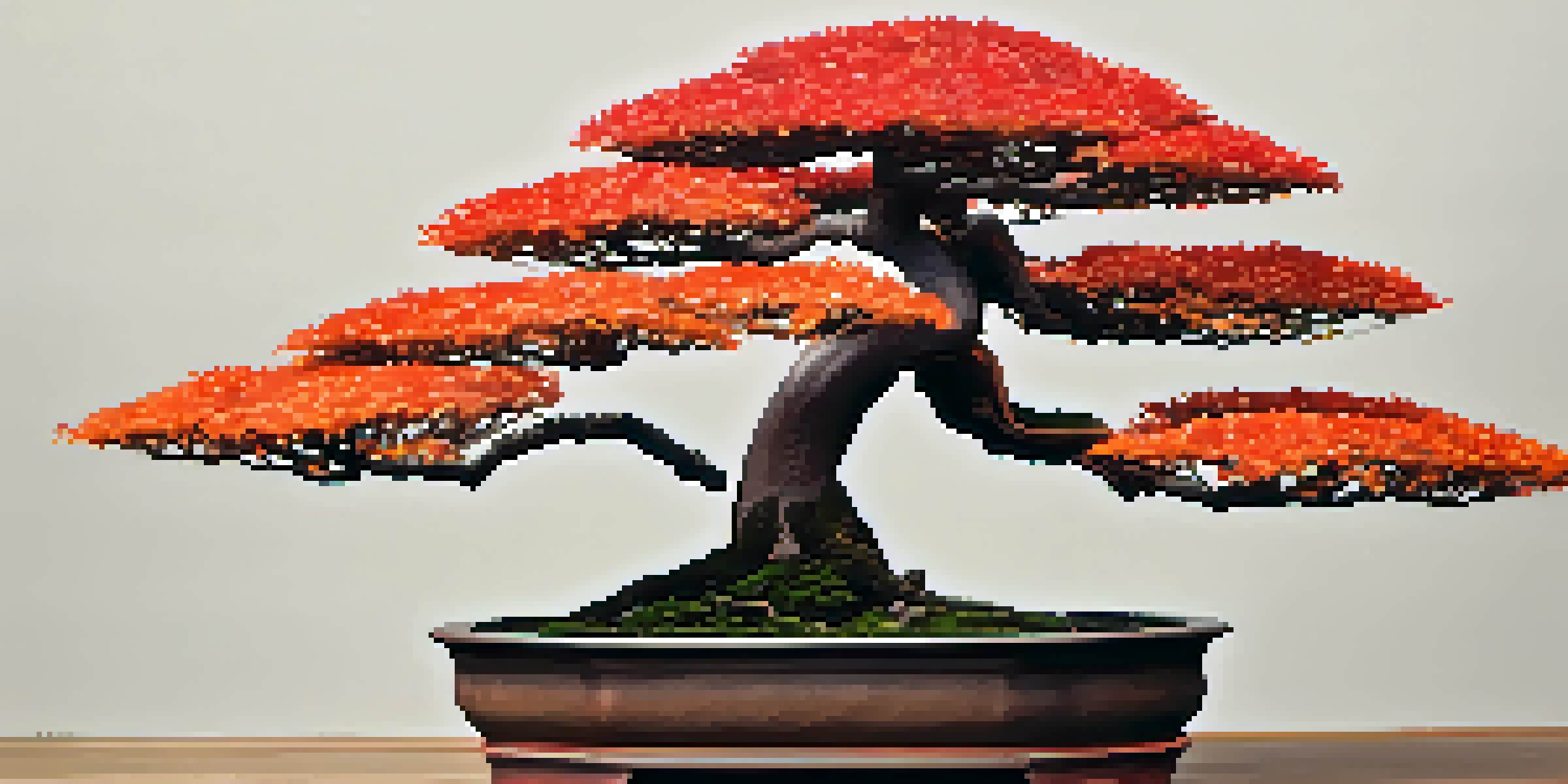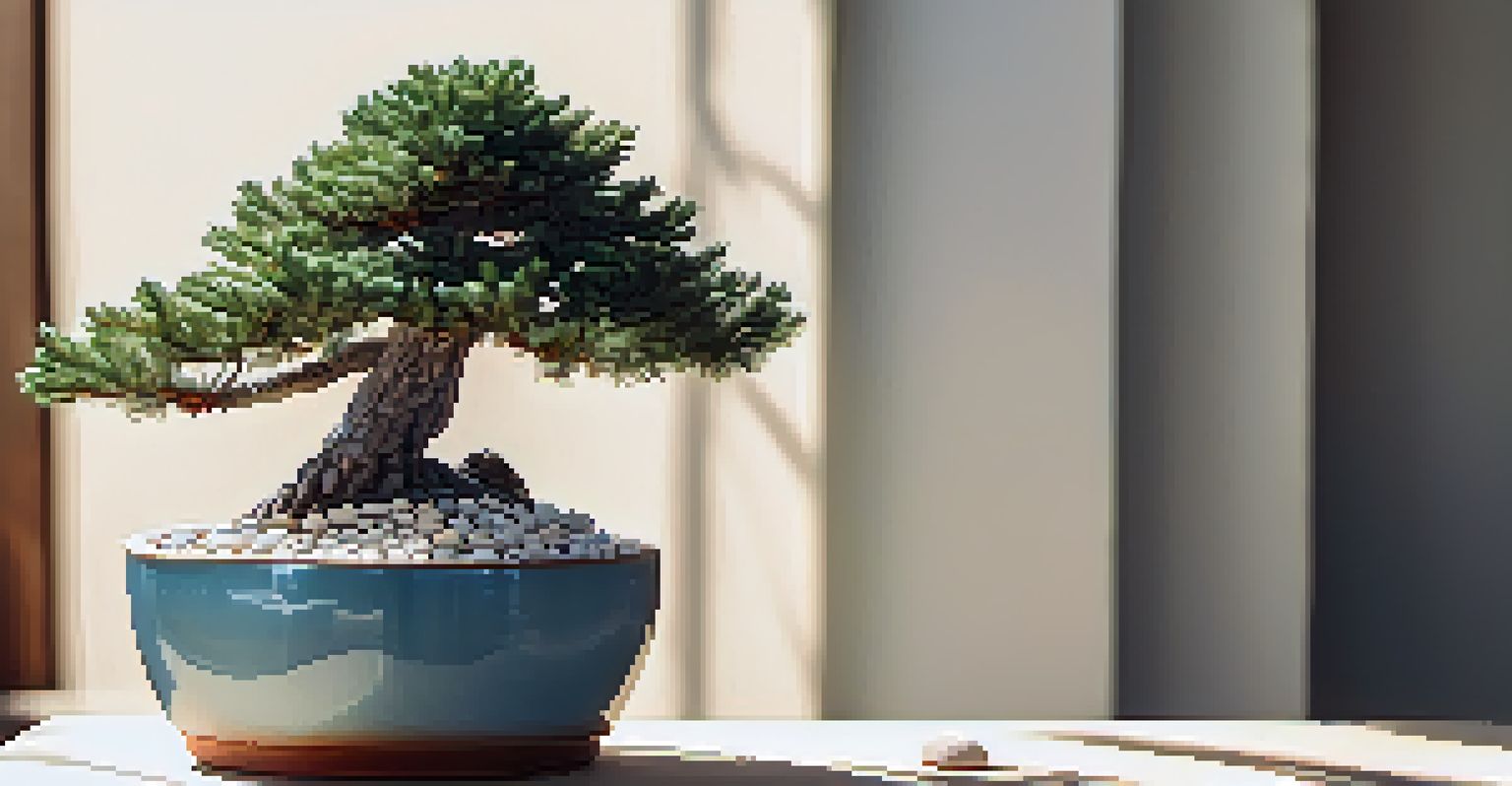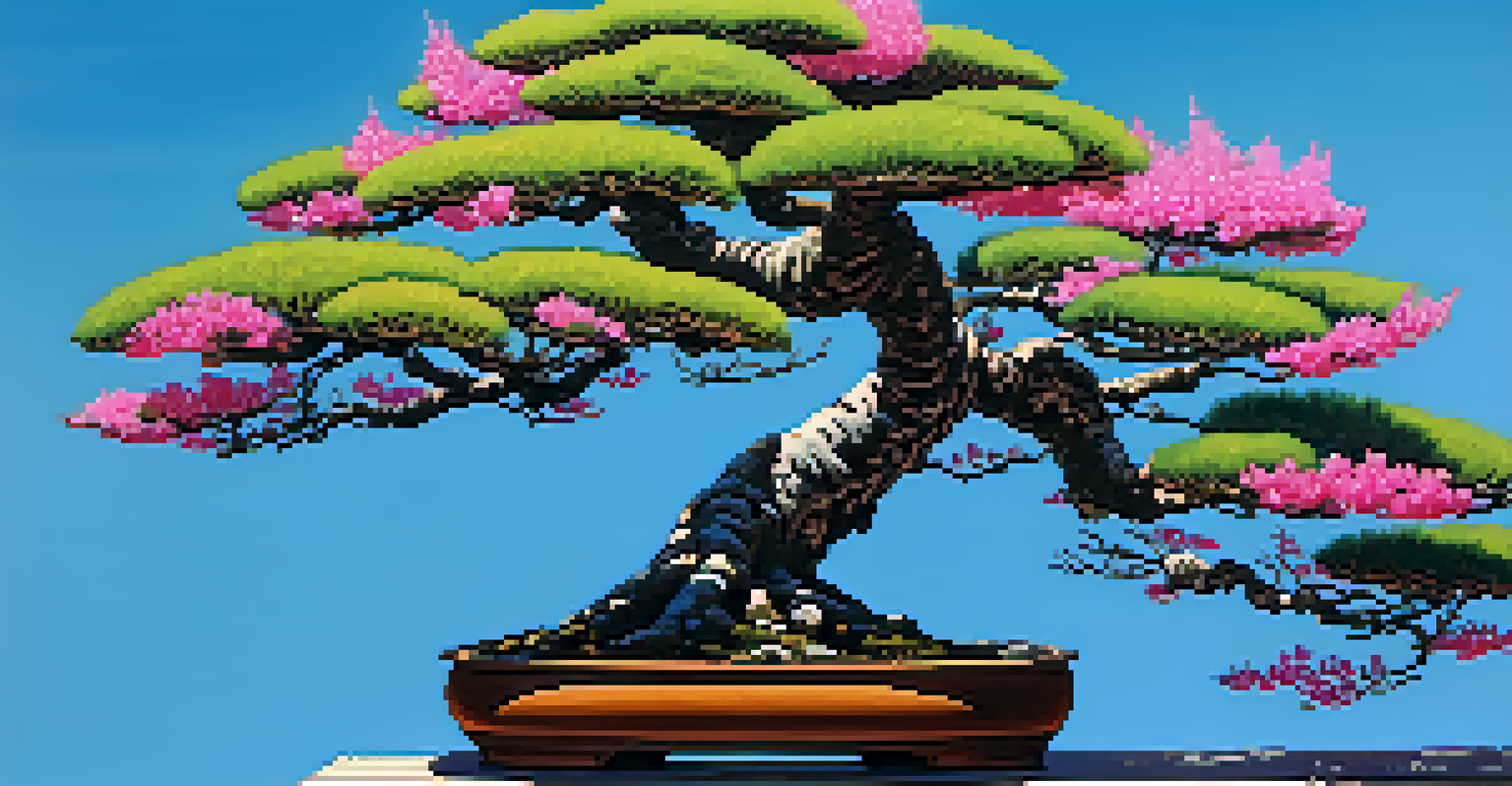Using Color in Bonsai: Enhancing Visual Appeal

The Importance of Color in Bonsai Aesthetics
Color plays a crucial role in the visual appeal of bonsai trees, influencing how we perceive their beauty. Just like the vibrant hues of a painting draw the eye, the colors in bonsai can evoke different emotions and reactions. From the rich greens of leaves to the earthy browns of the trunk, each shade contributes to the overall harmony of the composition.
Color is the keyboard, the eyes are the harmonies, the soul is the piano with many strings.
By understanding the significance of color, you can make more informed choices when selecting your bonsai. For instance, a bright red maple can bring a burst of energy, while a serene blue spruce offers a calming presence. This intentional use of color not only enhances the tree's appeal but also reflects your personal style and taste.
Moreover, color can serve as a storytelling tool in your bonsai journey. It allows you to create seasonal displays, matching the tree's hues with the changing environment outside. This connection to nature deepens the appreciation for your bonsai and adds a layer of meaning to its presence in your home.
Selecting the Right Bonsai Species for Color
When it comes to using color in bonsai, the choice of species is paramount. Different trees exhibit varying leaf colors, bark textures, and seasonal changes, making it essential to pick the right one for your vision. For example, the Japanese maple is revered for its stunning autumn foliage, showcasing fiery reds and oranges that catch the eye.

Conversely, evergreen species like junipers provide a consistent green backdrop, allowing you to play with pot colors and accessories. This stable hue can also highlight seasonal changes, as it contrasts beautifully with blooming flowers or colorful pots. The key is to choose a species that aligns with the color palette you envision for your bonsai.
Color Enhances Bonsai Aesthetics
The colors of a bonsai tree not only influence its visual appeal but also evoke emotions and reflect personal style.
Additionally, consider how the species you select will interact with its environment. A bonsai placed in a sunlit area may exhibit brighter colors than one in shade. Observing these dynamics will help you curate a living piece of art that evolves over time, providing endless opportunities for creative expression.
Enhancing Color with Pot Choice and Accessories
The pot you choose for your bonsai can dramatically influence its perceived color. A dark, earthy pot can amplify the brightness of a tree’s leaves, while a lighter pot offers a softer contrast. This interplay between the tree and its container can create a striking visual impact, drawing attention to the bonsai itself.
The beauty of nature is not a mere image; it is a living experience, a celebration of color and light.
Accessories like pebbles, moss, or decorative stones can further enhance the overall color scheme. For instance, using white pebbles around a green bonsai can create a fresh, clean look that highlights the tree's features. Think of these elements as the frame of a beautiful painting, enhancing the work without overshadowing it.
Ultimately, the goal is to create a cohesive look that showcases the bonsai's natural beauty. By being mindful of your pot choice and accessories, you can elevate the color dynamics and create a more engaging display that invites admiration and conversation.
Seasonal Color Changes: Embracing Nature's Palette
One of the fascinating aspects of bonsai is its ability to change colors with the seasons. In spring, new growth might showcase vibrant greens, while fall could bring an explosion of reds, oranges, and yellows. Embracing these seasonal shifts not only adds visual interest but also connects your bonsai to the natural world.
You can further enhance these changes by positioning your bonsai in ways that highlight seasonal contrasts. For example, placing a flowering bonsai against a backdrop of evergreens can make the blooms pop even more. This thoughtful arrangement allows you to celebrate the beauty of each season through your bonsai.
Species Choice Affects Color Dynamics
Selecting the right bonsai species is crucial, as different trees exhibit unique colors and textures that can enhance your desired aesthetic.
Additionally, understanding the seasonal cycles can guide your care routine, ensuring your tree remains healthy and vibrant. By tuning into these natural rhythms, you can enhance the color display of your bonsai year-round, creating a living masterpiece that changes with the seasons.
Using Lighting to Enhance Bonsai Colors
Lighting is another crucial factor in showcasing the colors of your bonsai. The right light can enhance the vibrancy of the leaves, revealing the full spectrum of hues. For instance, natural sunlight can make greens appear more vivid, while indirect light can soften the overall color palette, creating a gentle ambiance.
Consider the placement of your bonsai in relation to light sources. A tree positioned near a window may exhibit different shades than one kept in a darker corner. Experimenting with light can unlock new dimensions in your bonsai's appearance, making it an engaging focal point in your space.
However, be cautious not to expose your bonsai to too much direct sunlight, as this can scorch the leaves and diminish their vibrancy. Finding a balance is key to ensuring your bonsai remains colorful and healthy, allowing you to enjoy its beauty for years to come.
Color Theory: The Basics for Bonsai Enthusiasts
Understanding color theory can significantly enhance your approach to bonsai aesthetics. The basics, such as complementary and contrasting colors, can guide your choices in species, pots, and accessories. For instance, pairing a green bonsai with a red pot can create a striking visual effect, drawing the eye and creating balance.
Additionally, the concept of warm and cool colors can influence the mood of your display. Warm colors like reds and yellows evoke energy and warmth, while cool colors like blues and greens offer calmness and serenity. By mixing these colors thoughtfully, you can create an emotional response in viewers, making your bonsai not just a plant but a piece of art.
Lighting and Care Maintain Vibrancy
Proper lighting and regular care are essential for keeping your bonsai's colors vivid, ensuring it remains a vibrant centerpiece in your home.
As you delve deeper into color theory, you'll discover how to create a harmonious composition that reflects your personal style. This knowledge will empower you to curate a bonsai display that resonates with you and captivates those who admire your work.
Maintaining Color Vibrancy in Your Bonsai
To keep the colors of your bonsai vibrant, regular care is essential. This includes proper watering, fertilizing, and pruning, all of which contribute to the overall health of the tree. A well-nourished bonsai is more likely to exhibit bright, lively colors, making maintenance a crucial aspect of your care routine.
Incorporating organic fertilizers can enhance the color of your bonsai, providing essential nutrients that promote healthy growth. Additionally, ensuring your tree receives adequate sunlight will support its ability to produce vivid foliage. Remember, a vibrant bonsai is a happy bonsai!

Lastly, keep an eye on pests and diseases that can dull your tree's colors. Regular inspections and timely interventions can prevent any issues, allowing your bonsai to flourish and maintain its stunning appearance. With dedicated care, your bonsai can remain a colorful centerpiece in your home for years to come.